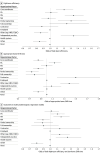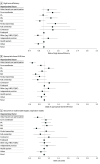Team and Electronic Health Record Features and Burnout Among Family Physicians
- PMID: 39499518
- PMCID: PMC11539011
- DOI: 10.1001/jamanetworkopen.2024.42687
Team and Electronic Health Record Features and Burnout Among Family Physicians
Abstract
Importance: In the context of a growing volume of electronic health record (EHR)-based work and post-COVID-19 pandemic staffing pressures, health system leaders need an up-to-date understanding of changes in family physicians' experiences of burnout, determinants of burnout, and how to enhance the family physicians' experience.
Objective: To evaluate the association of family physicians' perceptions of team structure and EHR experiences with burnout and identify modifiable practice structure factors associated with team and EHR experiences.
Design, setting, and participants: A serial cross-sectional survey study was conducted from December 1, 2016, to October 24, 2023. Participants included family physicians seeking continuous certification through the American Board of Family Medicine.
Main outcomes and measures: Yearly prevalence of burnout, perceived team efficiency, perceived EHR proficiency, and perceived EHR time were the outcomes. Multivariable logistic regression models subsequently assessed associations of team- and EHR-related experiences with burnout and the association between practice structure and staffing features in team efficiency and EHR time.
Results: The study included 10 315 physicians who answered the subset of questions related to burnout on the American Board of Family Medicine's Continuous Certification Questionnaire between 2017 and 2023. Among the sample, 5584 respondents (54.1%) were male, and the median age was 50 (IQR, 43-58) years. The proportion of physicians reporting burnout ranged from 37.9% in 2017 to a peak of 42.8% in 2022, which did not represent a significant temporal trend (P = .91). Appropriate home EHR use was associated with 0.58 (95% CI, 0.53-0.64; P < .001) times the odds of burnout, while high team efficiency was associated with 0.61 (95% CI, 0.56-0.67; P < .001) times the odds of burnout. Physician collaboration with a registered nurse was associated with greater odds of high team efficiency (odds ratio [OR], 1.35; 95% CI, 1.22-1.50). Collaboration with a physician assistant was associated with greater odds of appropriate home EHR time (OR, 1.13; 95% CI, 1.03-1.24).
Conclusions and relevance: In this national cross-sectional study of US family physicians, appropriate time spent on the EHR at home and primary care team efficiency were associated with lower odds of burnout. These findings suggest that clinical leaders and policymakers should focus on optimizing primary care team support and family physicians' EHR experiences to enhance the sustainability of primary care practice.
Conflict of interest statement
Figures




Comment in
- doi: 10.1001/jamanetworkopen.2024.42703
References
-
- Adler-Milstein J, Zhao W, Willard-Grace R, Knox M, Grumbach K. Electronic health records and burnout: time spent on the electronic health record after hours and message volume associated with exhaustion but not with cynicism among primary care clinicians. J Am Med Inform Assoc. 2020;27(4):531-538. doi:10.1093/jamia/ocz220 - DOI - PMC - PubMed
Publication types
MeSH terms
LinkOut - more resources
Full Text Sources
Medical

